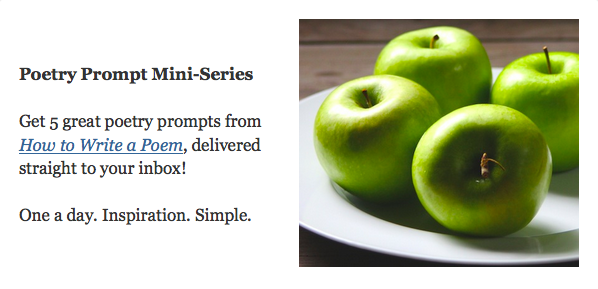Poetry With Children
What’s In My Journal
Odd things, like a button drawer. Mean
things, fishhooks, barbs in your hand.
But marbles, too. A genius for being agreeable.
Junkyard crucifixes, voluptuous
discards. Space for knickknacks, and for
Alaska. Evidence to hang me, or beatify.
Clues that lead nowhere, that never connected
anyway. Deliberate obfuscation, the kind
that takes genius. Chasms in character.
Loud omissions. Mornings that yawn above
a new grave. Pages you know exist
but you can’t find them. Someone’s terribly
inevitable life story, maybe mine.
—William Stafford
1.
I am nine years old, heading out for my first ever week away from home. Summer camp. I am terrified. For my birthday, the week before camp, a friend gives me a diary. It’s a small padded book, filled with thinly lined white paper and covered in pink cloth with polka dots on it.
I take it with me and fill its pages with my fears (I miss my parents, I want to go home, the other girls don’t understand, they make fun of me when I cry) and my feats (I went down the big water slide into the lake! I balanced a bugle on my fingers for four minutes! No one else did it even half so long!).
And I am hooked. I never stop writing in journals, though over the years I move away from padded pink polka dots to sleek black Moleskines with creamy blank pages.
2.
As I move into adolescence, I begin to write poetry in my journal. Maudlin verses about boys I like. Ballads based on literary characters I love. Heart-wrenched lines about my childhood friend who is killed in a freak accident.
I begin to see my journal as a place not simply to record what happens to me, but to record what I think about it, how I feel about it, who it is I’m becoming. After I read Anne Frank’s Diary, I give my journal a name, too. It—she—is my constant companion, the only friend to whom I bare my whole soul. I write lines or full letters to Kendi almost every day. She is the witness to my life.
3.
Twenty years later, I read William Stafford’s poem “What’s in My Journal, ” and I know exactly what he means. A life lived in scribbles on paper gradually accumulates into a mountain of meaning, big enough to contain Alaska, damning enough to execute, or saint.
The proud, scared girl who could balance a bugle on her index and middle fingers for four minutes is now a proud, scared woman who balances a blog, a book, and four children. I have to use my whole body now and my whole mind, too, and the balance is precarious, always in danger of tumbling down in a broken heap. But when you come to think about it, the girl used her whole body and mind, too, focusing intently on the movement of the bugle, moving her arm, her feet in response to its swaying, to keep it upright and balanced, however precariously, on her fingers.
Snippets of a life circle back and around and in and through, themes and leitmotifs recurring and only visible in recorded retrospect.
4.
I read Stafford’s poem to my students, four boys and a girl, ages 8 to 12. We look up the hard words: voluptuous, beatify, obfuscation. We talk about images and metaphors and the way Stafford mixes concrete objects with character traits and metaphors to create a portrait of a life. We talk about how even the objects are metaphors, since he doesn’t really have fishhooks in his journal, or Alaska.
I ask what’s in their journals.
“I don’t have a journal, ” the eight-year-old says.
“That’s okay, ” the eleven-year-old, the only girl, tells him. “Just think about what would be in it if you had one.”
He comes up with this: A blank piece of paper and a pencil. The land of playing. Softness and hardness like a rock.
They read around the circle, and I record their words, each line a glimpse into a child’s soul.
What’s In Our Journals
A blank piece of paper and a pencil.
The land of playing.
Softness and hardness like a rock.
The inevitability of getting up early.
Pages of writing.
Boredom.
The ticking of a clock.
A sweater made of clouds.
The blank pages of a dictionary.
Paint and paper.
A leap from a skyscraper. A soft landing on the ground.
Discovering and misunderstanding the clue.
An arrow whistling through the air.
A sailboat racing from the page.
Me wanting to steer it.
—Brady Diffner, Holden Diffner, Jackson Diffner, Jack Ireton, Diya Wilson
5.
I wonder if these children will grow up to have sailboats and cloud-sweaters and base-jumping in the days to come. I wonder, if they do, will they remember the lines of this poem they wrote? How they were already projecting themselves into their own futures, how their child selves were molding the people they were still to become?
I think of my own life, my own journal, and all that is in it. Green cat’s eyes winking in the dark. A gas stove, stainless steel skillet, onions sautéing in butter. Years of anxious worry poured onto the page. Baby fingers clutching the soft flesh under my arm. The tedium of laundry and dishes and diaper changes. First smiles. First laughter. First words.
And always, my words, flowing like water or wrestled like Jacob’s angel through my fingers onto the blank canvas of my days.
Photo by Claire Haidar, Creative Commons license via Flickr. Post by Kimberlee Conway Ireton, author of The Circle of Seasons: Meeting God in the Church Year.
______________________________
Click to get FREE 5-Prompt Mini-Series
- Top 10 YA and Children’s Books - July 25, 2014
- Literary Birthdays: Dorothy Sayers’ Gaudy Night - June 13, 2014
- Literary Birthdays: C.S. Lewis, Louisa May Alcott, Madeleine L’Engle - November 29, 2013


Donna says
Flooded.
She is flooded with
thoughts and feelings and flashes
of journals by the dozens
gone forever and wondering
did she invite her own amnesia
each moment she threw one away?
———-
Kimberlee… this is a great post! I love it all, and I love the poems you have shared here, and that line from Stafford “Pages you know exist but you can’t find them” blew me away. Lucky children, these children, to have you as their guide and mentor and the one who would introduce them to this way of laying down words and feelings if for no other reason than that they, by virtue of their ‘owners’, have value.
Kimberlee Conway Ireton says
Thank you, Donna. I’m not always sure I’m a great guide and mentor, but this day was one of my favorites in our workshop 🙂
Maureen Doallas says
Lovely post, Kimberlee. The thoughts from the children that you fashioned into a poem work beautifully together, even movingly. What happens in our culture that children who see like this stop seeing like this as they move into adulthood?
And Stafford is a favorite!
Kimberlee Conway Ireton says
Thanks, Maureen! I just watched Sir Ken Robinson’s TED talk from 2006 on how education kills creativity. He says that we educate children out of their creativity.
Also, from a purely neurological perspective, unless we cultivate certain ways of seeing (in ourselves, in our children), we give that brain space over to other ways of seeing, the ways we actually use.
Too often I think it’s that we simply don’t appreciate the unique ways children (or other adults) see and express their seeing. I know I get all caught up in my own vision and don’t always listen to my children’s. I’m working on listening more. The workshop was good for helping me shut up and listen 🙂
Irene O'Garden says
How nice to discover you and your work, today, Kimberlee. (Thanks to Don Share) I appreciate your sensitivity to the inspiring work of children. I work with local children in the national River Of Words program, which connects kids with their watershed via poetry and art. We encourage kids to make their own journals, and have a yearly Poetry Trail where we letter some of their work, and hang it in a natural area. It seems to me the more we can make poetry a physical event for children (and adults) the more firmly it becomes couched in our lives. And by the way, I too write in a chunky spiral notebook 6×6! happy writing!
Kimberlee Conway Ireton says
Irene, Yes! The more we can help children see that writing is a real-world activity, that it means something in their lives and the lives of others, the more likely they’ll be to embrace it. So cool that you post your kids’ writing in natural areas for others to read and enjoy!
Megan Willome says
Dang, Kimberlee. This is fantastic!
Of course, I already loved Stafford’s poem, so I had context going in. But you fleshed it out so well, in so many different ways.
Kimberlee Conway Ireton says
Thank you, Megan, so much. You just made my day 🙂
Jody Collins says
Wow, when I first began to read I thought, “You can’t really speak to the ideas of poetry and journals at this young age, can you?”
Well, you can and you did. So wonderful.
Bless you, Kimberlee.
p.s. you played the bugle???! wow.
Anna says
This is a wonderful post, Kimberlee. Love how “the snippets of a life circle back around.”
I remember the very first poem I wrote– I was in first grade and scribbled some rhymes about holidays. We all start somewhere. 🙂
I imagine some of your students will remember their lines, too.
What a gift, joy, and privilege it is to pour out our lives in words.
Diana Trautwein says
This is gorgeous, Kimberlee. What a gift to those children, to encourage their ‘inner poet.’ That cloud-sweater line just got me somehow. Beautifully done – thank you.